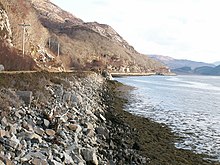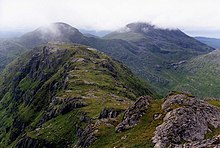Moidart
This articleneeds additional citations forverification.(May 2016) |
Moidart(/ˈmɔɪdɑːrt/MOY-dart;Scottish Gaelic:Mùideart[ˈmuːitʲarˠʃt̪]) is part of the remote and isolated area ofScotland,west ofFort William,known as theRough Bounds.Moidart itself is almost surrounded by bodies of water.Loch Shielcuts off the eastern boundary of the district (along a south-south-west to north-north-east line) and continues along part of the southern edge. The remainder of the southern edge is cut off byLoch Moidart.The north is cut off byLoch MorarandLoch Ailort.
Moidart is currently part of the district ofLochaber,in theHighlandcouncil area. It includes the townships ofDorlin,KinlochmoidartandGlenuig.At Dorlin isCastle Tioram,a former fortress ofClann Ruaidhríand theClanranaldbranch ofClan Donald.
Moidart forms part of theMorar, Moidart and Ardnamurchan National Scenic Area,[1]one of 40 such areas in Scotland, which are defined so as to identify areas of exceptional scenery and to ensure its protection by restricting certain forms of development.[2]
History
[edit]Early history
[edit]
Following raids byvikings,Moidart became part of theKingdom of the Isles,a Norwegian dependency. It was in this period that Moidart acquired its name, from theOld Norsemod,meaningmud,and the Norse suffix-art,derived fromfjord;the whole name thus meansmuddy loch,and refers to Loch Moidart in particular (whose name is thustautologous). In the late 11th century,Malcolm III of Scotlandmade a written agreement withMagnus Barelegs,the Norwegian king, which moved the border to the coast; Moidart thus became Scottish.
In the early 12th century,Somerled,aNorse-Gaelof uncertain origin, came into possession of Moidart and the surrounding region; no reliable record explains how this happened, but at some point in the 1140s,David I of Scotland's control of the region had been eroded.[3]In the early part of the century, in the 1130s, Somerled launched a coup in the Kingdom of the Isles, which resulted in that kingdom joining his other possessions, as a single independent state. Upon Somerled's death, Norwegian authority was restored, but in practice, the kingdom was divided; the portion containing Moidart was known asGarmoran,and ruled by theMacRory,a faction among Somerled's heirs.

Following the 1266Treaty of Perth,Garmoran became a Scottish crown dependency – theLordship of Garmoran– still ruled by the MacRory, until the sole MacRory heir wasAmy of Garmoran.At around this time,Castle Tioramwas built, in Loch Moidart, as the principal seat of the Lordship of Garmoran. Most of the remainder of the Kingdom of the Isles had become theLordship of the Isles,ruled by theMacDonalds,whose leader,John of Islay,married Amy. After the birth of three sons, he divorced Amy and married the king's niece, in return for a substantialdowry.
As part of the arrangement, John deprived his eldest son,Ranald,of the ability to inherit the Lordship of the Isles, in favour of a son by his new wife; as compensation, he made Ranald the Lord of Garmoran.
However, at the end of the 14th century, on Ranald's death, his sons were still children, and Ranald's younger brother Godfrey took the opportunity to seize the Lordship of Garmoran. Furthermore, theheirs of Ranald's other brother Murdochnow made their own claim. This involved Godfrey's family (theSiol Gorrie) and those of his brothers in a great deal of violent conflict which is not described in much detail in surviving records.

In 1427, frustrated with the level of violence generally in the highlands, together with the insurrection caused byhis own cousin,KingJames Idemanded that highland magnates should attend a meeting atInverness.On arrival, many of the leaders were seized and imprisoned. Alexander MacGorrie, son of Godfrey, was considered to be one of the two most reprehensible, and after a quickshowtrial,was immediately executed.[4]As Alexander had by now inherited Godfrey'sde factoposition as Lord of Garmoran, and in view of Ranald's heirs being no less responsible for the violence, King James declared the Lordship forfeit.
Lairdship grants
[edit]
In 1469, James' grandson (James III) grantedLairdshipof the lands of Garmoran and Uist toJohn,the Lord of the Isles. In turn, John passed it to his own half-brother,Hugh of Sleat;the grant to Hugh was confirmed bythe kingin a 1493 charter. The violence that led to Alexander's execution had brought the Siol Gorrie to the brink of extinction, and after Alexander's death they played no further part in Moidart's history.[4]
Ranald's heirs (Clan Ranald) disputed and fought against the charter. Following Hugh of Sleat's death, in 1498, and for reasons that are not remotely clear, his son John immediately resigned, transferring all authority to the king. In 1532, the king granted Moidart to the leader of Clan Ranald, JohnMoidartach.The charter granting him the lands also acknowledged his ownership of the lands of his former uncle,Ranald Bane,who had been granted the adjacent lands ofArisaigsome 30 years earlier.
In 1609, following a degree of lawlessness in the region, John's grandson Donald was imprisoned. Donald was only released on condition of being obedient to the king,James VI,and the king's law; in return, James granted Donald a second charter to his lands.
Later history
[edit]
TheRough Boundsbecame a hotbed ofJacobitesympathy. Following the failure of theJacobite rising of 1745,it was the last part of Scotland in whichBonnie Prince Charliefound sanctuary. Finally leaving Scotland fromLoch nan Uamh,he took seven prominent men with him, who despite their places of origin became known as theSeven Men of Moidart(the Second Duke of Atholl, Aeneas MacDonald – brother of the local Laird, Francis Strickland – an aristocratic EnglishRecusant,George Kelly – IrishPresbyterian minister,and three officers from theFrench Royal Army'sIrish Brigade); a commemorative row ofbeechtrees was planted a century later.
In an April 1787 letter from Moidart to theCongregation for Propagandain Rome, Fr. Austin MacDonald wrote, "On account of the emigration of the people ofKnoydarttoCanada,along with theirpriest;it fell to me in the autumn to attend to those who were left behind, and during the winter to the people of Moydart (sic) as well. Although not less than 600 Catholics went toAmerica,still I administered theSacramentsto over 500 souls who remained. The overpopulation of these districts, together with the oppression of the landlords, are the principal causes of the departure of so many, not only among the Catholics, but also among the Protestants. "[5]
Unlike many other areas of Jacobite sympathy, no attempt was made to establish amilitary roadinto Moidart, and it remained without road access until theA861was built, in 1966 (after receiving approval in 1963[6]). Prior to that, other than a rough footpath, it could only be accessed by a ferry running betweenLochailort(at the north of Moidart) andGlenuig(in the west). It wasn't until 1988 that it became possible for residents to have a connection to the mains electricity supply.
The remoteness ensured the persistence both of Catholicism, despite theScottish Reformation,[7]and of theGaeliclanguage. The area remained strongly Gaelic-speaking until the mid 20th century – in the 1881 census, around 90% of the population were able to speak Gaelic and over a third unable to speak English, though by 2001 the share of Gaelic speakers had declined to under 15% of habitual residents.[8]
The lack of connectivity before the 1960s also made the area an ideal training location for special operational units duringWorld War II.SeveralSOEparamilitarytraining bases were sited in the area, and HMSDorlinwas established at Dorlin, and used for training ofRoyal NavyBeach Signals andRoyal Signalssections.
Famous people
[edit]- Alasdair mac Mhaighstir Alasdair,18th centuryScottish Gaelicpoet andJacobite
- Fergie MacDonaldwas raised in the area.
References
[edit]- ^"National Scenic Areas - Maps".SNH. 20 December 2010. Archived fromthe originalon 12 June 2018.Retrieved14 May2018.
- ^"National Scenic Areas".Scottish Natural Heritage.Retrieved14 May2018.
- ^MacDonald, IG (2013).Clerics and Clansmen: The Diocese of Argyll between the Twelfth and Sixteenth Centuries.The Northern World: North Europe and the Baltic c. 400–1700 AD. Peoples, Economics and Cultures (series vol. 61). Leiden:Brill.ISBN978-90-04-18547-0.ISSN1569-1462.,p. 37;Woolf, A(2004). "The Age of Sea-Kings, 900–1300". In Omand, D (ed.).The Argyll Book.Edinburgh:Birlinn.pp. 94–109.ISBN1-84158-253-0.,p. 102.
- ^abGregory, Donald (1836),History of the Western Highlands and Isles of Scotland, from A.D. 1493 to A.D. 1625, with a brief introductory sketch, from A.D. 80 to A.D. 1493,Edinburgh, W. Tait,retrieved11 May2012,p. 65
- ^Odo Blundell (1917),The Catholic Highlands of Scotland. Volume II: The Western Highlands and Islands,Sands & Co., 37 George Street,Edinburgh,15 King Street,Covent Garden,London.p. 145.
- ^"Tourist Road in Moidart. Approval for Gran".The Glasgow Herald.12 April 1963. p. 1.Retrieved26 December2016.
- ^Sara Maitland, "I sat alone in silence and was absorbed into the mystery of beauty",The Tablet,10 August 2019 p. 9
- ^Duwe, Kurt C."Vol. 01: Àird nam Murchan & Loch Abar an Iar"(PDF).Scottish Gaelic Local Studies.Archived from the original on 2 November 2005.Retrieved23 April2017.
{{cite web}}:CS1 maint: unfit URL (link)
Sources
[edit]- Rev. Charles Macdonald,Moidart, or among the Clanranalds(1889)
